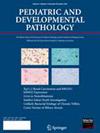Diagnostic Challenges and Emerging Pathogeneses of Selected Glomerulopathies
IF 1.3
4区 医学
Q3 PATHOLOGY
引用次数: 0
Abstract
Recent progress in glomerular immune complex and complement-mediated diseases have refined diagnostic categories and informed mechanistic understanding of disease development in pediatric patients. Herein, we discuss selected advances in 3 categories. First, membranous nephropathy antigens are increasingly utilized to characterize disease in pediatric patients and include phospholipase A2 receptor (PLA2R), Semaphorin 3B (Sema3B), neural epidermal growth factor-like 1 (NELL1), and protocadherin FAT1, as well as the lupus membranous-associated antigens exostosin 1/2 (EXT1/2), neural cell adhesion molecule 1 (NCAM1), and transforming growth factor beta receptor 3 (TGFBR3). Second, we examine advances in techniques for paraffin and light chain immunofluorescence (IF), including the former’s function as a salvage technique and their necessity for diagnosis in adolescent cases of membranous-like glomerulopathy with masked IgG kappa deposits (MGMID) and proliferative glomerulonephritis with monotypic Ig deposits (PGNMID), respectively. Finally, progress in understanding the roles of complement in pediatric glomerular disease is reviewed, with specific attention to overlapping clinical, histologic, and genetic or functional alternative complement pathway (AP) abnormalities among C3 glomerulopathy (C3G), infection-related and post-infectious GN, “atypical” post-infectious GN, immune complex mediated membranoproliferative glomerulonephritis (IC-MPGN), and atypical hemolytic uremic syndrome (aHUS).部分肾小球疾病的诊断挑战和新病原体
肾小球免疫复合物和补体介导疾病方面的最新进展完善了诊断类别,并使人们对儿科患者的疾病发展机理有了更深入的了解。在此,我们将讨论三个方面的进展。首先,膜性肾病抗原越来越多地被用于描述儿科患者的疾病特征,其中包括磷脂酶 A2 受体 (PLA2R)、Semaaphorin 3B (Sema3B)、神经表皮生长因子样 1 (NELL1)、和原粘连蛋白 FAT1,以及狼疮膜相关抗原外胚层蛋白 1/2(EXT1/2)、神经细胞粘附分子 1(NCAM1)和转化生长因子 beta 受体 3(TGFBR3)。其次,我们研究了石蜡和轻链免疫荧光(IF)技术的进展,包括前者作为挽救性技术的功能,以及它们在诊断青少年膜样肾小球病伴有遮蔽性 IgG kappa 沉积(MGMID)和增殖性肾小球肾炎伴有单型 Ig 沉积(PGNMID)病例中的必要性。最后,综述了补体在小儿肾小球疾病中的作用,特别关注了C3肾小球病(C3G)、感染相关和感染后GN、"非典型 "感染后GN、免疫复合物介导的膜增生性肾小球肾炎(IC-MPGN)和非典型溶血性尿毒症综合征(aHUS)在临床、组织学和遗传或功能性替代补体途径(AP)异常方面的重叠。
本文章由计算机程序翻译,如有差异,请以英文原文为准。
求助全文
约1分钟内获得全文
求助全文
来源期刊
CiteScore
3.70
自引率
5.30%
发文量
59
审稿时长
6-12 weeks
期刊介绍:
The Journal covers the spectrum of disorders of early development (including embryology, placentology, and teratology), gestational and perinatal diseases, and all diseases of childhood. Studies may be in any field of experimental, anatomic, or clinical pathology, including molecular pathology. Case reports are published only if they provide new insights into disease mechanisms or new information.

 求助内容:
求助内容: 应助结果提醒方式:
应助结果提醒方式:


